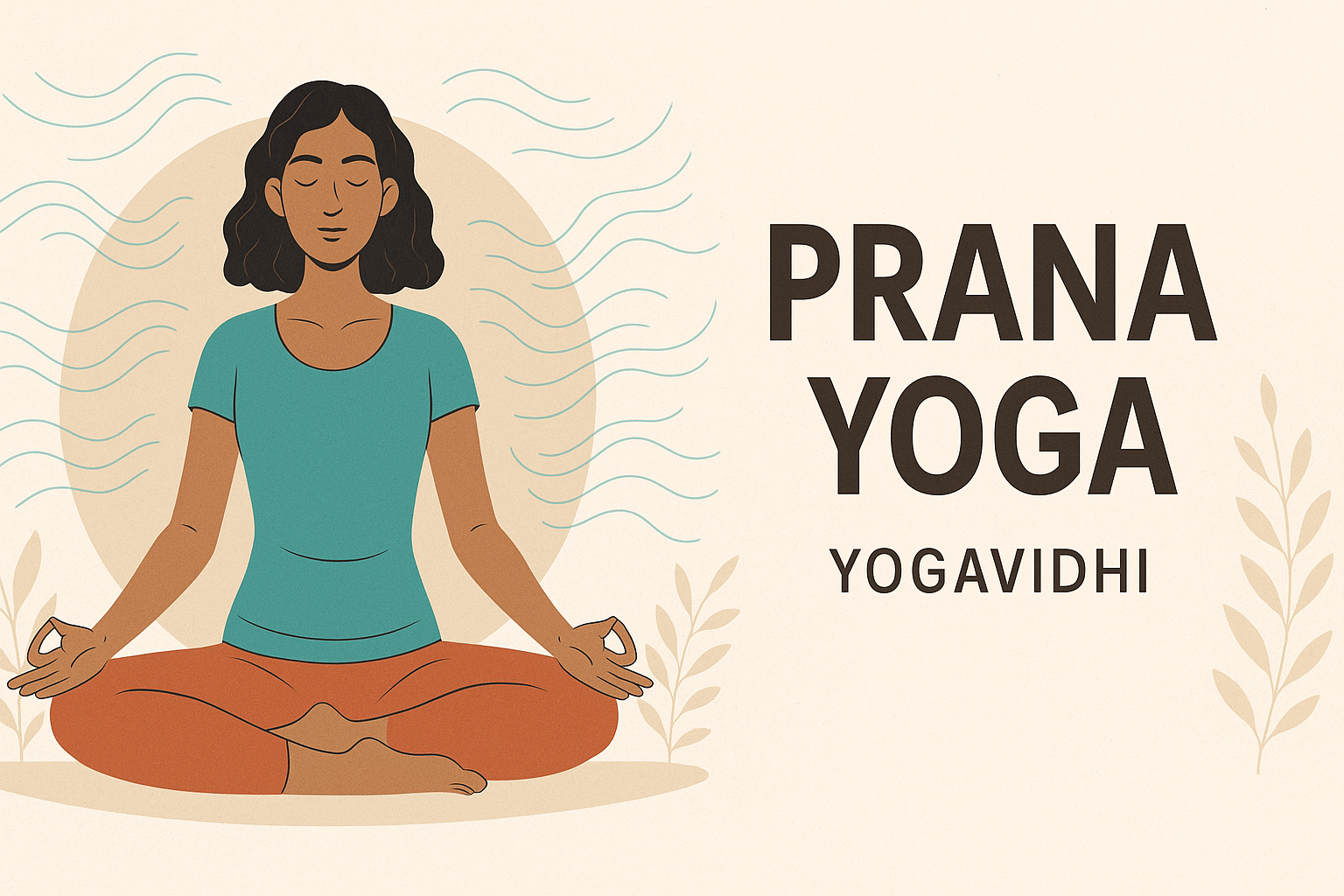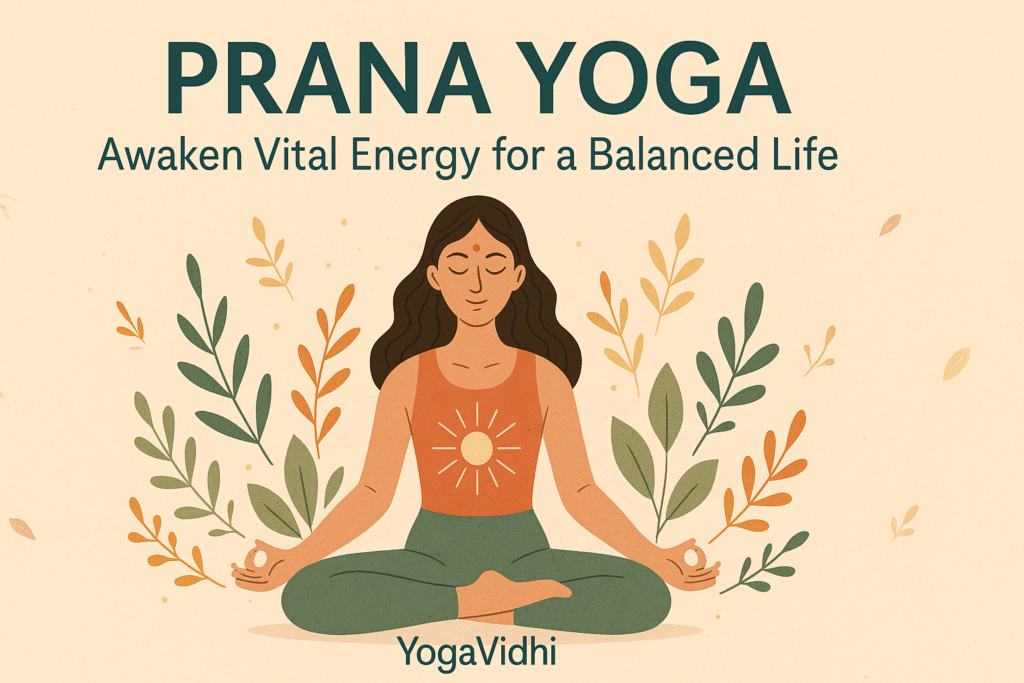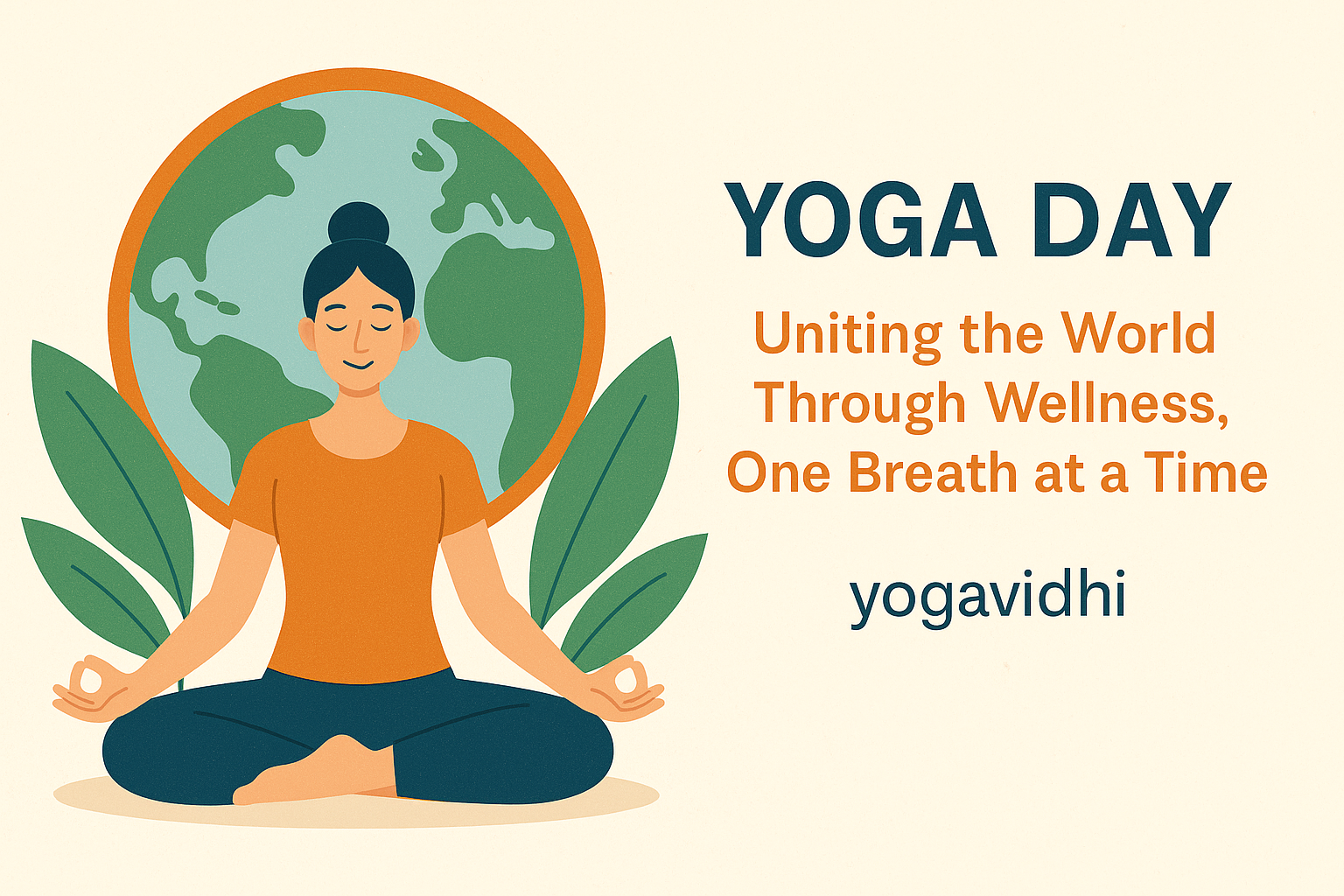In today’s fast-paced world, where stress, fatigue, and anxiety have become almost second nature, people are turning toward holistic practices that nourish both the body and mind. One such powerful practice is Prana Yoga—a transformative form of yoga that focuses on the life force within us.
If you’re looking for deep rejuvenation, heightened awareness, and natural healing, Prana Yoga can be the key to restoring your energetic balance. Let’s dive into everything you need to know about this deeply revitalizing yoga practice.
In yoga and related traditions, Prana (प्राण) is known as the vital life force or energy that sustains all living beings and flows throughout the universe. It is the fundamental source of vitality and motion, often equated with the breath or the force that enlivens both body and mind. Gaining control and awareness of Prana through practices like pranayama (breath regulation) is a central element in both yoga and Ayurveda.
Table of Contents
What Is Prana Yoga?
At its core, Prana Yoga is more than just physical postures—it’s a spiritual and energetic system that revolves around prana, the vital life force that sustains every living being. The word Prana comes from Sanskrit, meaning “life energy” or “breath,” and Yoga means “union.” Together, Prana Yoga unites the body, mind, and breath to awaken and direct this energy.
Unlike traditional yoga forms that may emphasize flexibility or strength, Prana Yoga emphasizes the conscious flow of energy through breathwork (pranayama), meditative awareness, and gentle asanas designed to unblock and circulate prana.
Key Elements of Prana Yoga:
- Focus on breathing techniques
- Awareness of energy centers (chakras)
- Mindful movement to stimulate energy flow
- Meditation to harmonize internal rhythms
The Science and Philosophy Behind Prana
Prana is not just a mystical idea—it’s a concept rooted in both yogic philosophy and science. According to ancient yogic texts like the Upanishads and the Hatha Yoga Pradipika, prana is the invisible force that animates the body. It travels through subtle energy channels known as nadis, and centers at major points in the body called chakras.
When prana flows freely, you feel vibrant, balanced, and at peace. But when it’s blocked—due to stress, poor lifestyle habits, or emotional trauma—energy stagnates, and illness or mental unrest may arise.
Scientific studies on breath-based yoga show improvements in heart rate variability, oxygen saturation, and stress hormone regulation. These effects validate what yogis have known for centuries: when the breath is steady and conscious, the mind becomes calm and the body heals.
Core Components of a Prana Yoga Practice
1. Pranayama (Breath Control Techniques)
Breathing is central to Prana Yoga. Through specific pranayama techniques, you can purify the nadis and recharge your energy field. Here are a few powerful ones:
- Nadi Shodhana (Alternate Nostril Breathing): Balances the left and right brain hemispheres, calms the nervous system, and purifies energy channels.
- Kapalabhati (Skull-Shining Breath): Energizes the brain, strengthens the lungs, and clears mental fog.
- Bhramari (Bee Breath): Soothes anxiety and promotes tranquility by activating the parasympathetic nervous system.
2. Asanas that Enhance Prana Flow
In Prana Yoga, physical postures are used not for fitness, but to free energy blockages and enhance the movement of prana.
Some highly beneficial asanas include:
- Bhujangasana (Cobra Pose): Opens the heart chakra and boosts energy.
- Matsyasana (Fish Pose): Stimulates the throat chakra and improves breathing.
- Ustrasana (Camel Pose): Invigorates the spine and energizes the whole body.
3. Meditation and Visualization
Prana Yoga encourages inner awareness, helping you visualize energy movement through the chakras and body.
Guided meditations often include:
- Chakra alignment visualization
- Golden light breathing to cleanse energy
- Inner silence to recharge mental energy
Read More: Daily Yoga: Transform Your Life One Pose at a Time
Read More: Gaia Yoga: Reconnect with Earth, Spirit, and Self
Benefits of Prana Yoga
1. Boosts Vitality and Immunity
Regular practice enhances oxygen intake and improves blood circulation, which strengthens the immune system and increases your stamina throughout the day.
2. Reduces Stress and Anxiety
Deep breathing and meditation in Prana Yoga lower cortisol levels, helping you feel calmer and more grounded.
3. Enhances Focus and Mental Clarity
Prana Yoga increases oxygen flow to the brain, sharpening memory and concentration. It’s ideal for those struggling with brain fog or decision fatigue.
4. Promotes Emotional Balance
Breathwork helps release trapped emotions, resulting in greater emotional resilience and inner peace.
5. Encourages Spiritual Growth
By awakening and channeling prana, this practice leads to higher states of awareness and a deeper connection to your spiritual self.
Prana Yoga vs. Traditional Yoga
| Feature | Traditional Yoga | Prana Yoga |
| Focus | Physical fitness, flexibility | Energy flow and breath |
| Intensity | Often physical and dynamic | Gentle, breath-focused |
| Tools | Asanas, sometimes meditation | Pranayama, chakras, visualization |
| Goal | Strength & flexibility | Energetic balance & vitality |
| Suitable For | General fitness seekers | Those seeking inner healing & spiritual connection |
Prana Yoga isn’t meant to replace traditional yoga, but to deepen it. If you’ve ever felt like your yoga practice lacks an energetic or spiritual component, this could be your missing link.
How to Start Practicing Prana Yoga
Starting Prana Yoga doesn’t require any special equipment or advanced flexibility. Here’s how you can ease into the practice:
1. Set the Mood
Create a serene, quiet space free from distractions. Soft music or incense can enhance your focus.
2. Begin with Breath Awareness
Start by observing your breath. Then move into a simple pranayama sequence like Nadi Shodhana for 5 minutes.
3. Incorporate Gentle Asanas
Flow through heart-opening postures, spinal stretches, and shoulder releases. Don’t rush—focus on your breath.
4. Add Meditation
After your breathwork and asanas, sit in meditation. Visualize prana flowing through your body, recharging every cell.
5. Stay Consistent
Aim for 15–30 minutes a day. Morning is ideal, as energy is most vibrant at sunrise.
Prana Yoga in Modern Wellness
As holistic health gains traction, Prana Yoga is emerging as a powerful healing modality. Many yoga therapists, Ayurvedic practitioners, and energy healers incorporate Prana Yoga into treatment protocols for:
- Chronic fatigue
- Anxiety and depression
- Autoimmune disorders
- Hormonal imbalances
Online platforms now offer Prana Yoga classes, guided meditations, and breathwork workshops, making this ancient practice more accessible than ever.
Real-Life Transformations with Prana Yoga
Many practitioners report dramatic changes in their well-being after adopting a regular Prana Yoga practice.
Aarti, a 39-year-old IT professional, says:
“I was always tired and anxious. Within a month of practicing Prana Yoga every morning, my energy improved, and I finally felt calm after years of stress.”
Ramesh, 52, shares:
“I had high blood pressure and insomnia. Pranayama and visualization helped me sleep better and reduce medication naturally.”

Final Thoughts: Is Prana Yoga Right for You?
If you’re seeking more than just a physical workout—if you’re looking to reconnect with your energy, regain inner balance, and experience holistic vitality—then Prana Yoga is absolutely worth exploring.
Whether you’re a complete beginner or a seasoned yogi, the beauty of Prana Yoga lies in its simplicity, depth, and power. Begin where you are, breathe with awareness, and let your inner energy guide you toward healing and transformation.
Frequently Asked Questions (FAQs)
Q. What is the main goal of Prana Yoga?
Ans: The goal is to awaken and balance the vital life force (prana) through breathwork, meditation, and movement for overall well-being.
Q. Can beginners practice Prana Yoga safely?
Ans: Yes, it’s suitable for all levels. The practice is gentle, breath-based, and adaptable to individual needs.
Q. How often should I do Prana Yoga for best results?
Ans: Ideally, practice daily for 15–30 minutes to see noticeable physical, mental, and emotional improvements.
Q. Does Prana Yoga require advanced flexibility?
Ans: Not at all. The focus is on breath and energy flow, not complex poses. Beginners can start comfortably.
Q. What’s the difference between Prana and breath?
Ans: While breath is the physical act of inhaling and exhaling, prana is the subtle energy carried by the breath.
Q. What is the prana yoga method?
Ans: The Pranayoga Method is a teaching approach rooted in hatha yoga. Its practice focuses on enhancing the awareness and movement of Prana, or “vital energy,” within the physical body as well as in the subtle layers of the mind and higher spiritual dimensions of being.
Q. What are the 5 Pranas in yoga?
Ans: The five Pranas, called Pancha Pranas or Pancha Vayus—Prana, Apana, Samana, Udana, and Vyana—each regulate specific body parts and functions.
Q. What are prana yoga exercises?
Ans: Pranayama involves the conscious control of breathing—deliberately inhaling, exhaling, and holding the breath in a defined pattern. Its purpose is to harmonize the body and mind. In yoga, pranayama is typically practiced together with physical postures (asanas) and meditation (dhyana).
Q. How do I activate prana?
Ans: Prana can be harnessed and directed through practices like pranayama (breath control), meditation, yoga, and by maintaining mindful awareness of the breath and body during daily activities.
Declaration Note:
We use third-party videos and images on https://yogavidhi.com/ for educational and illustrative purposes. All rights belong to their respective owners. No copyright infringement is intended.



